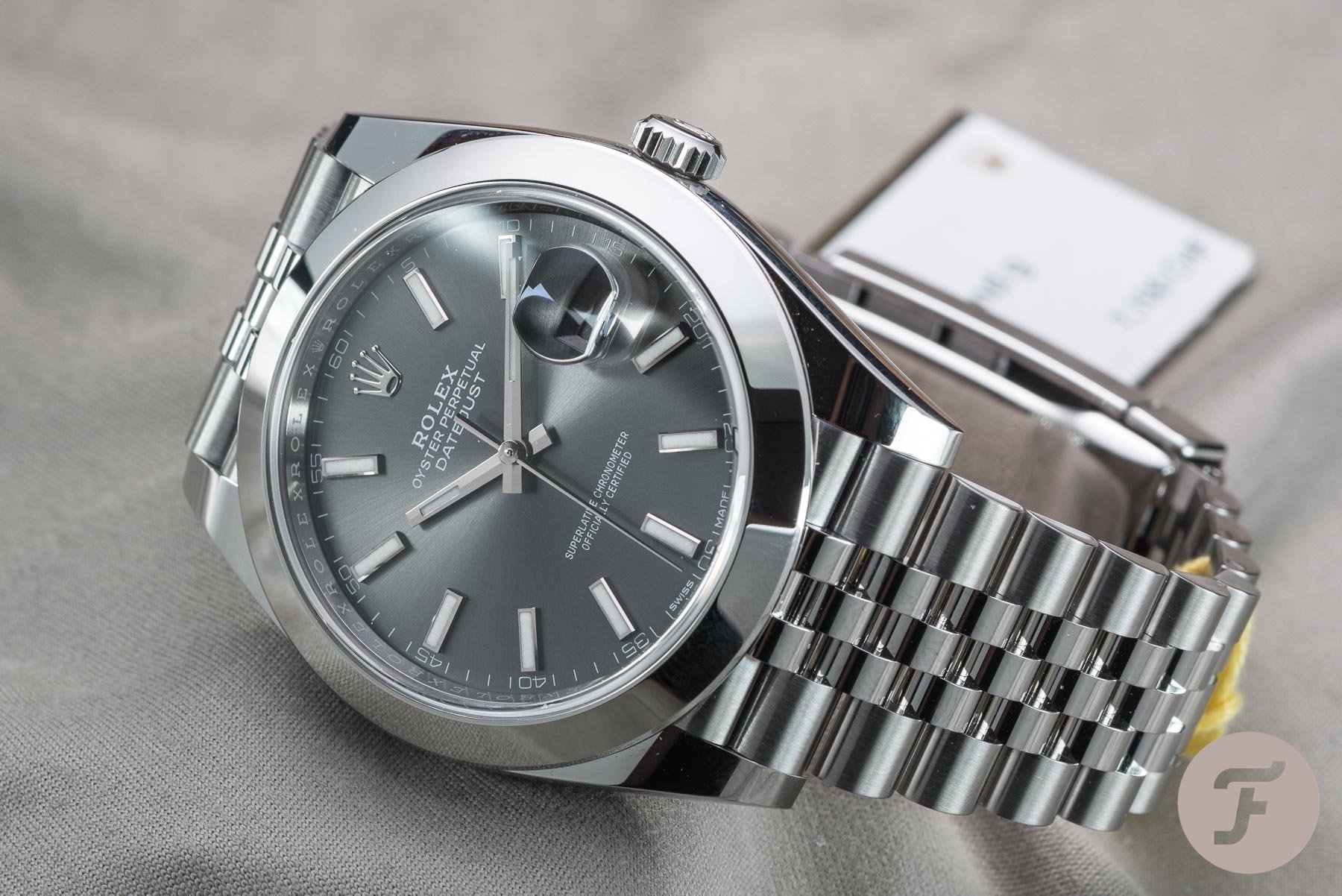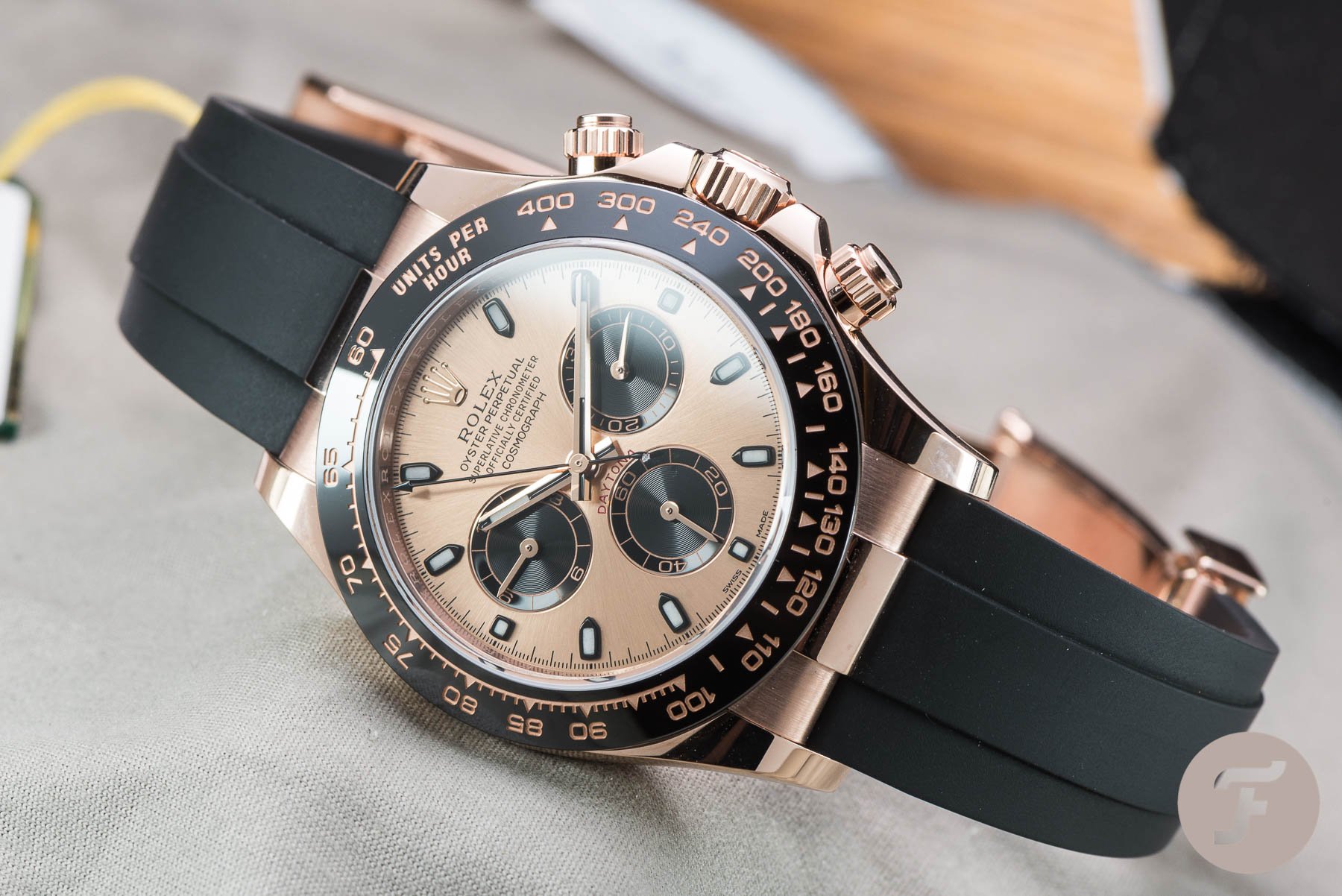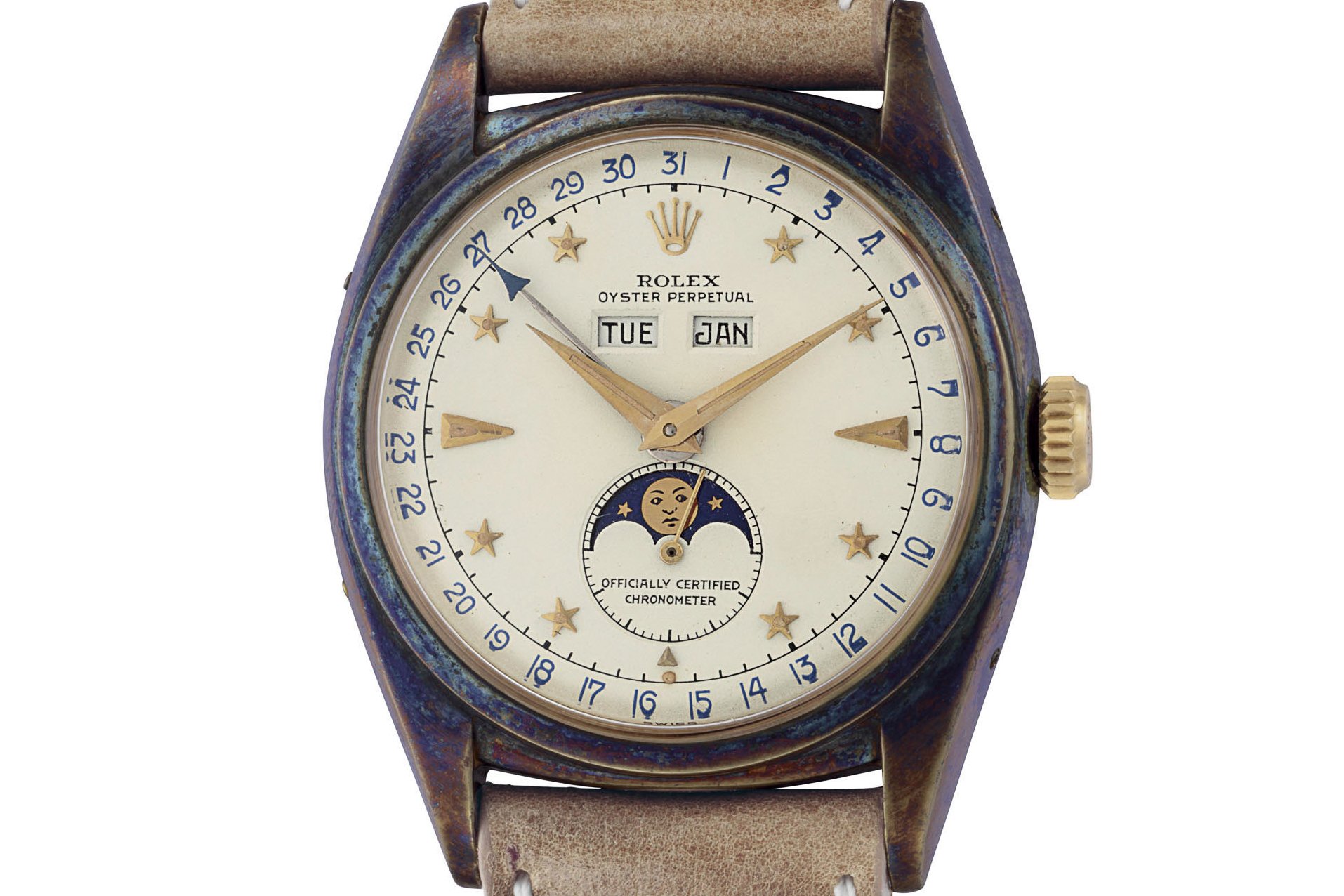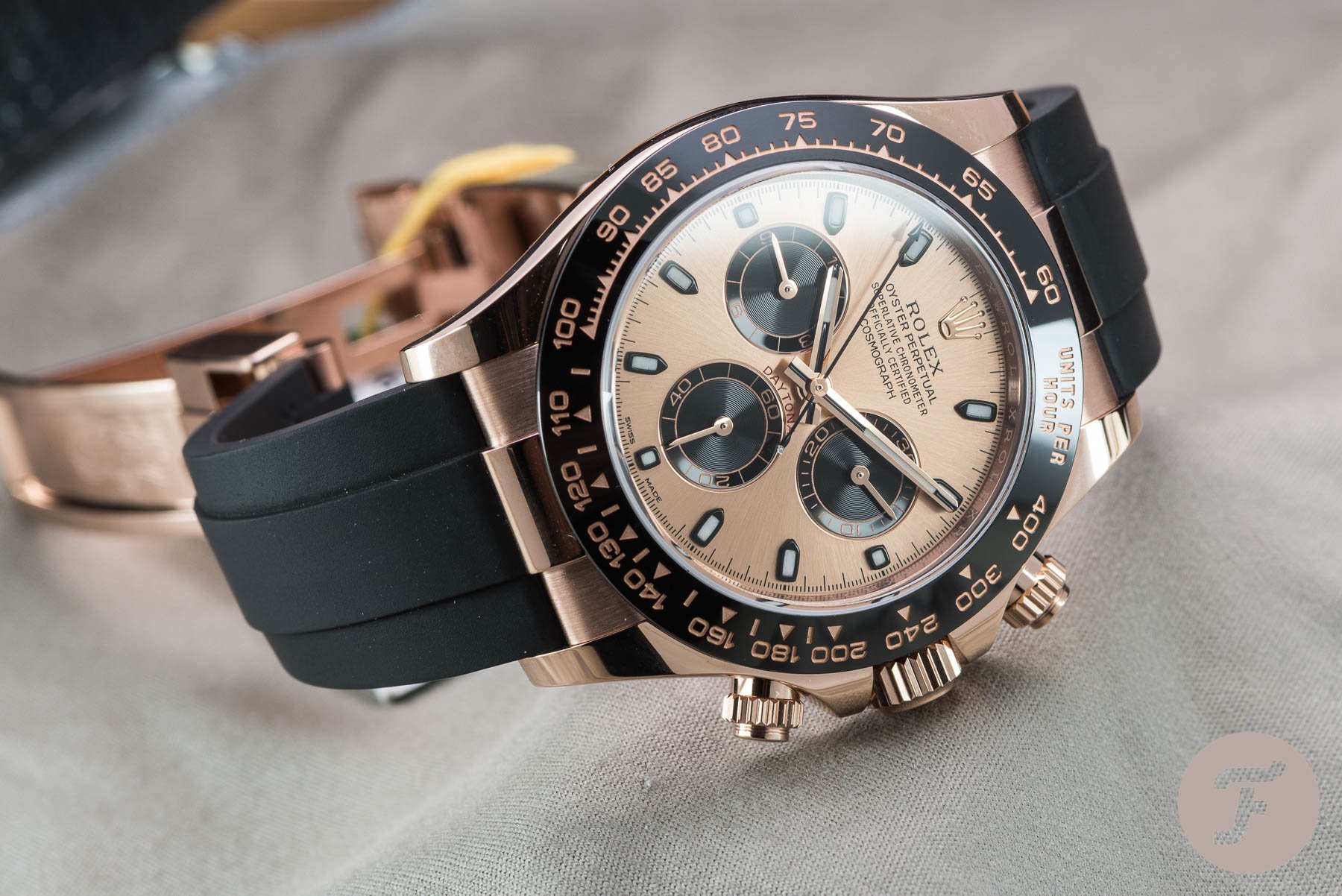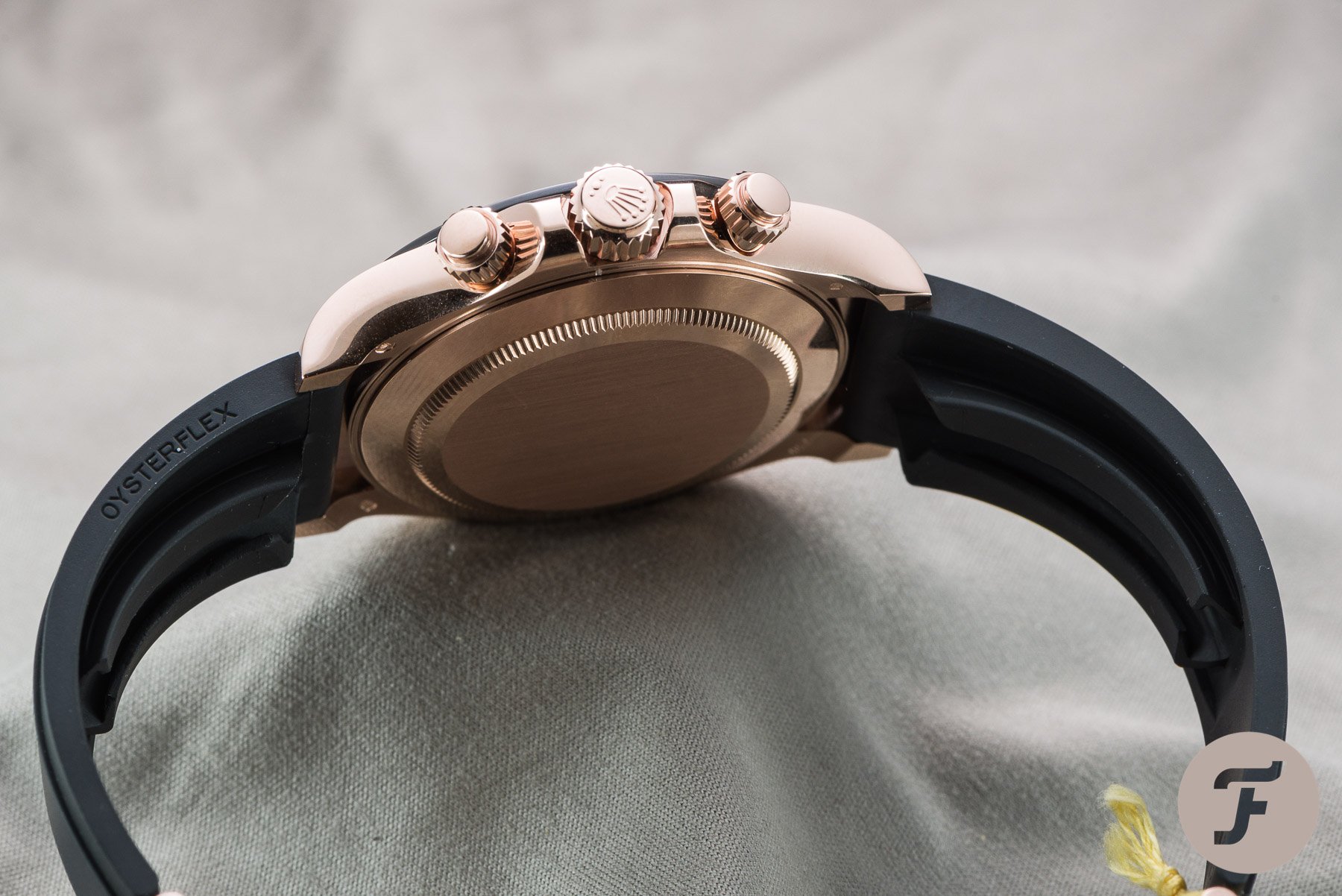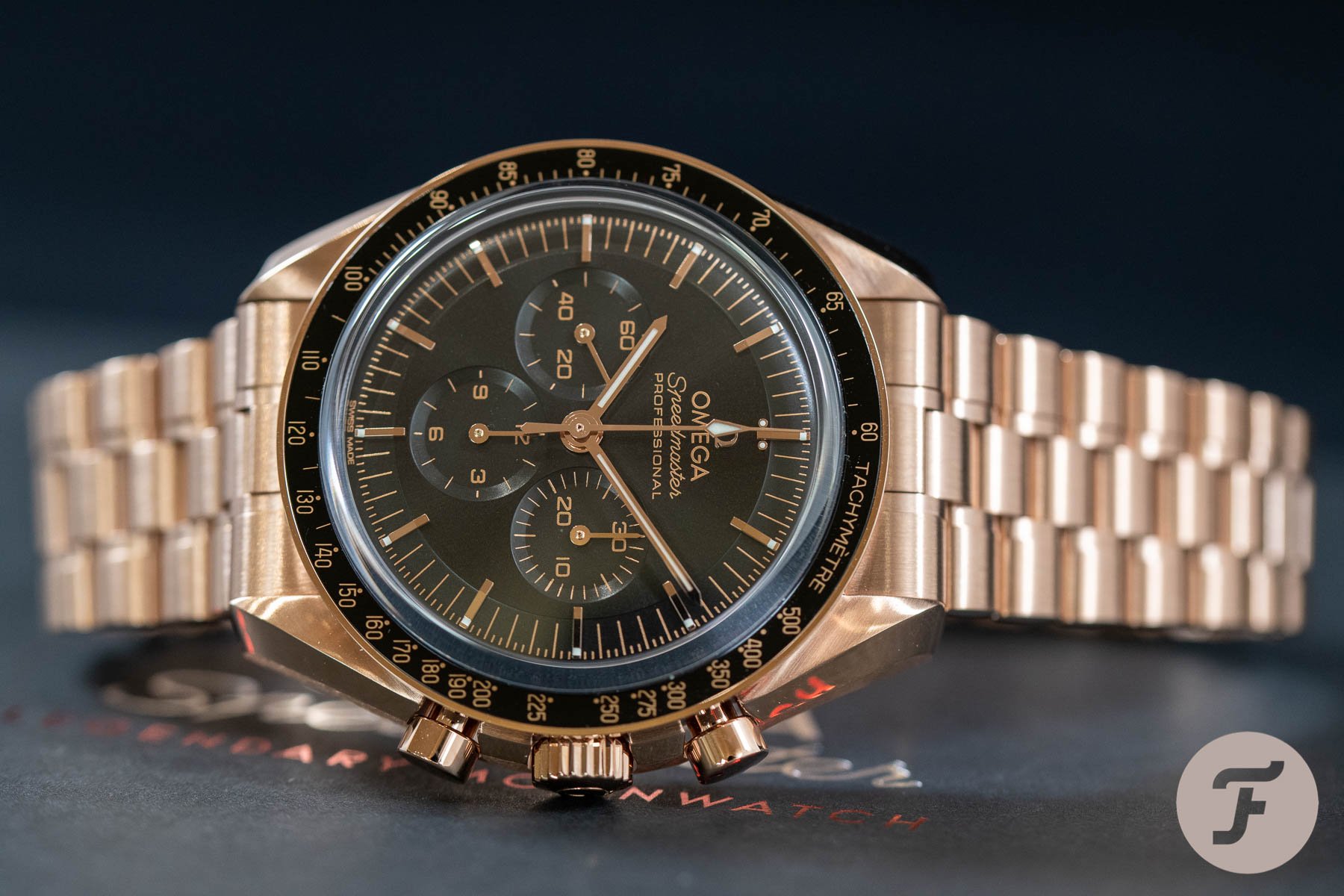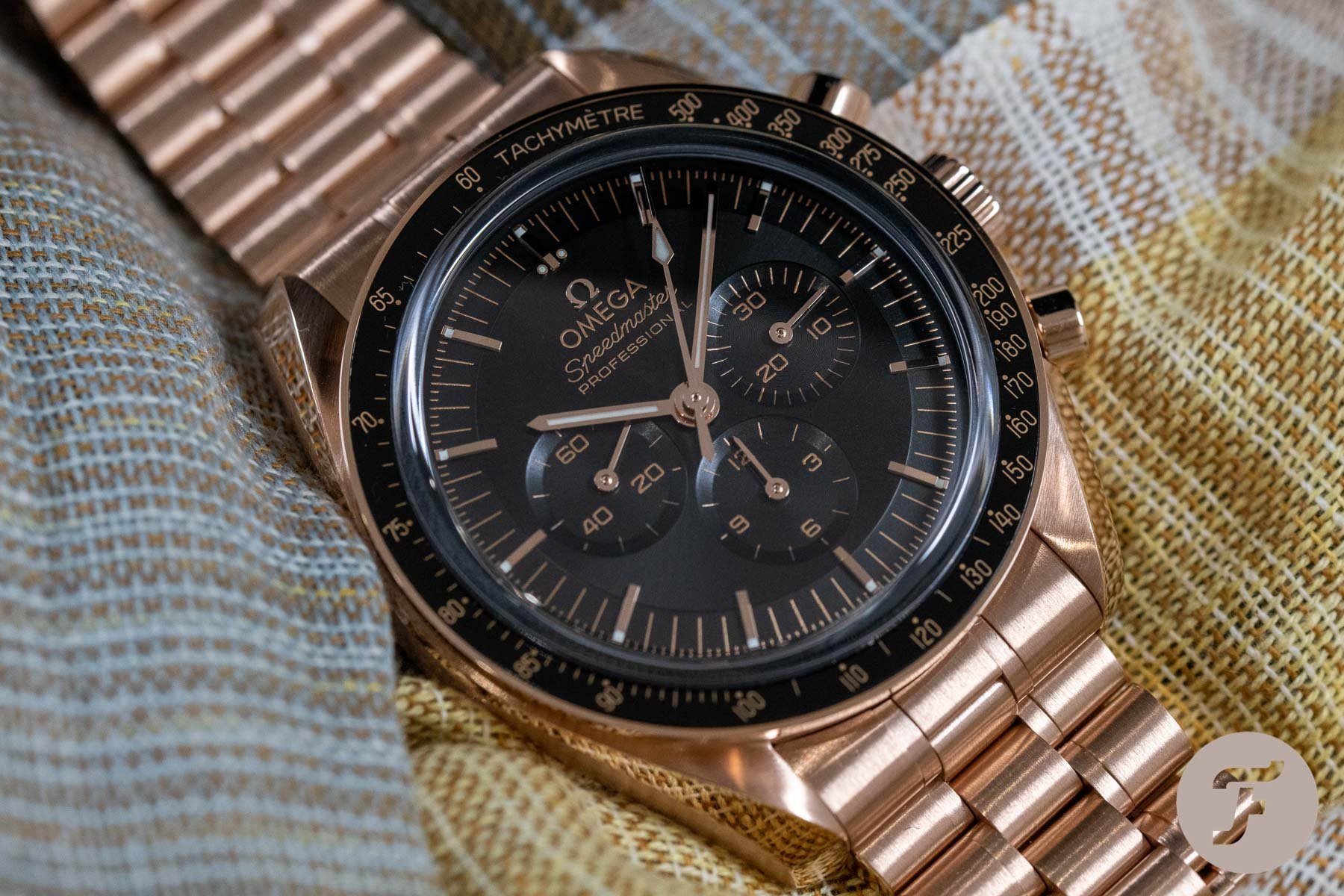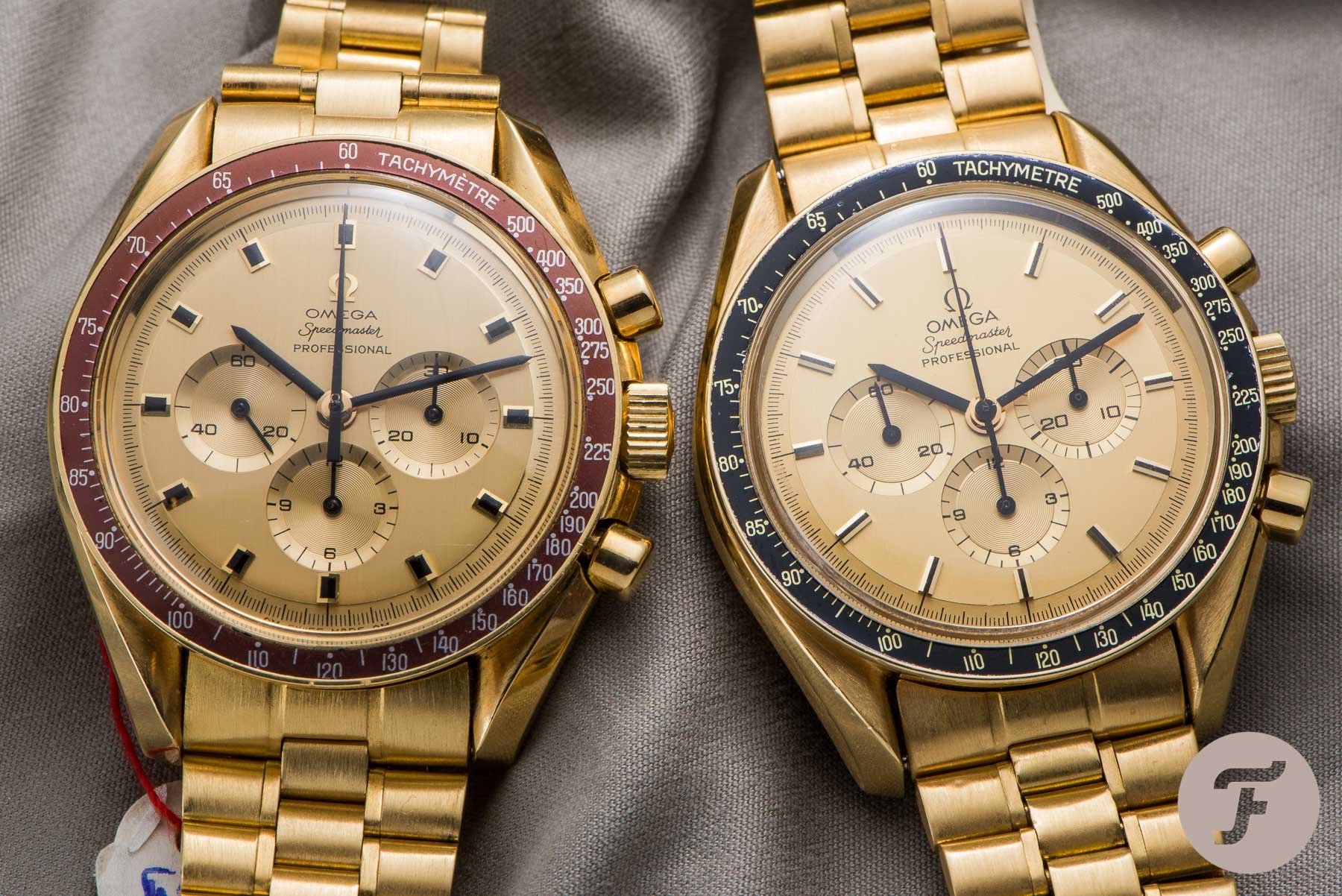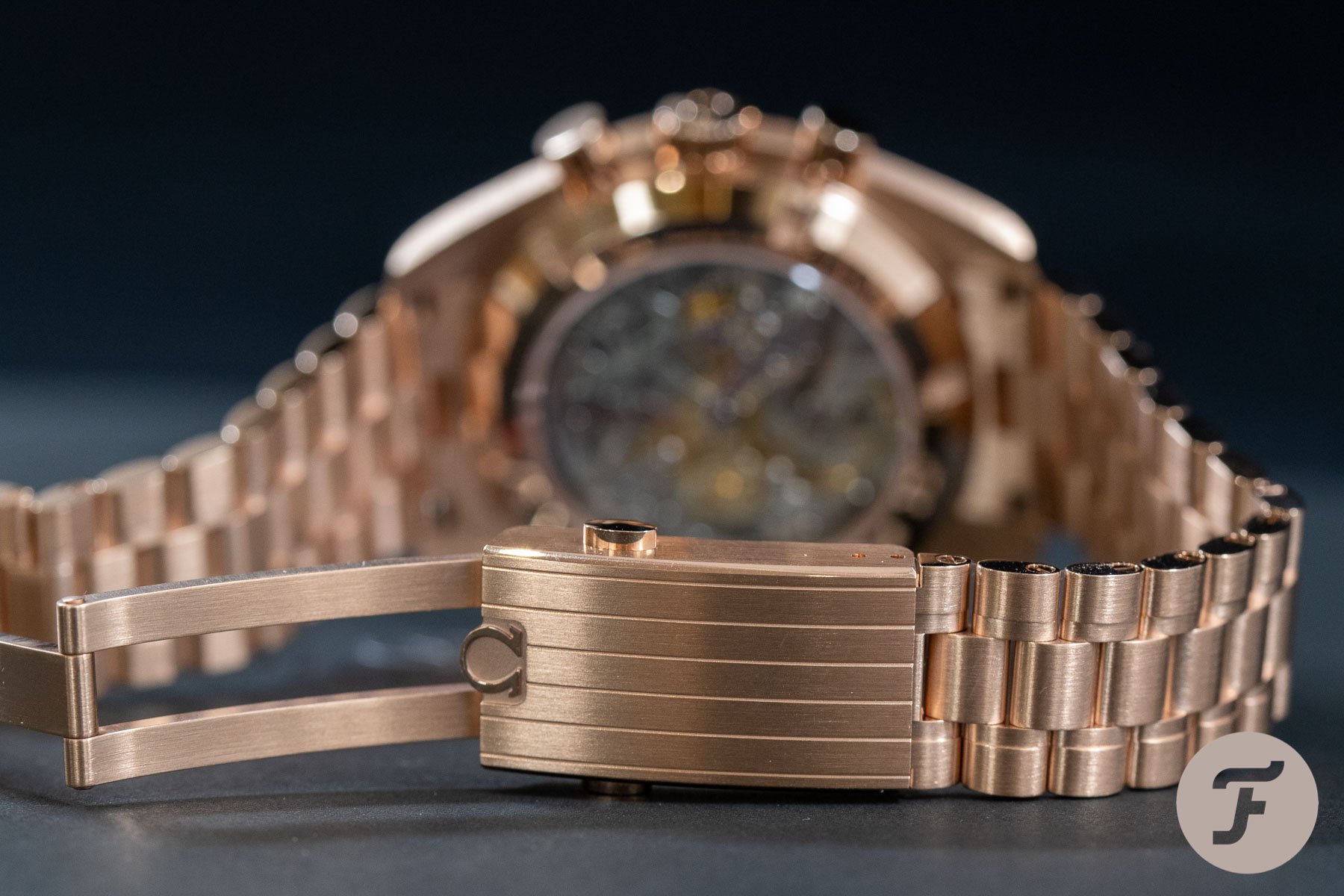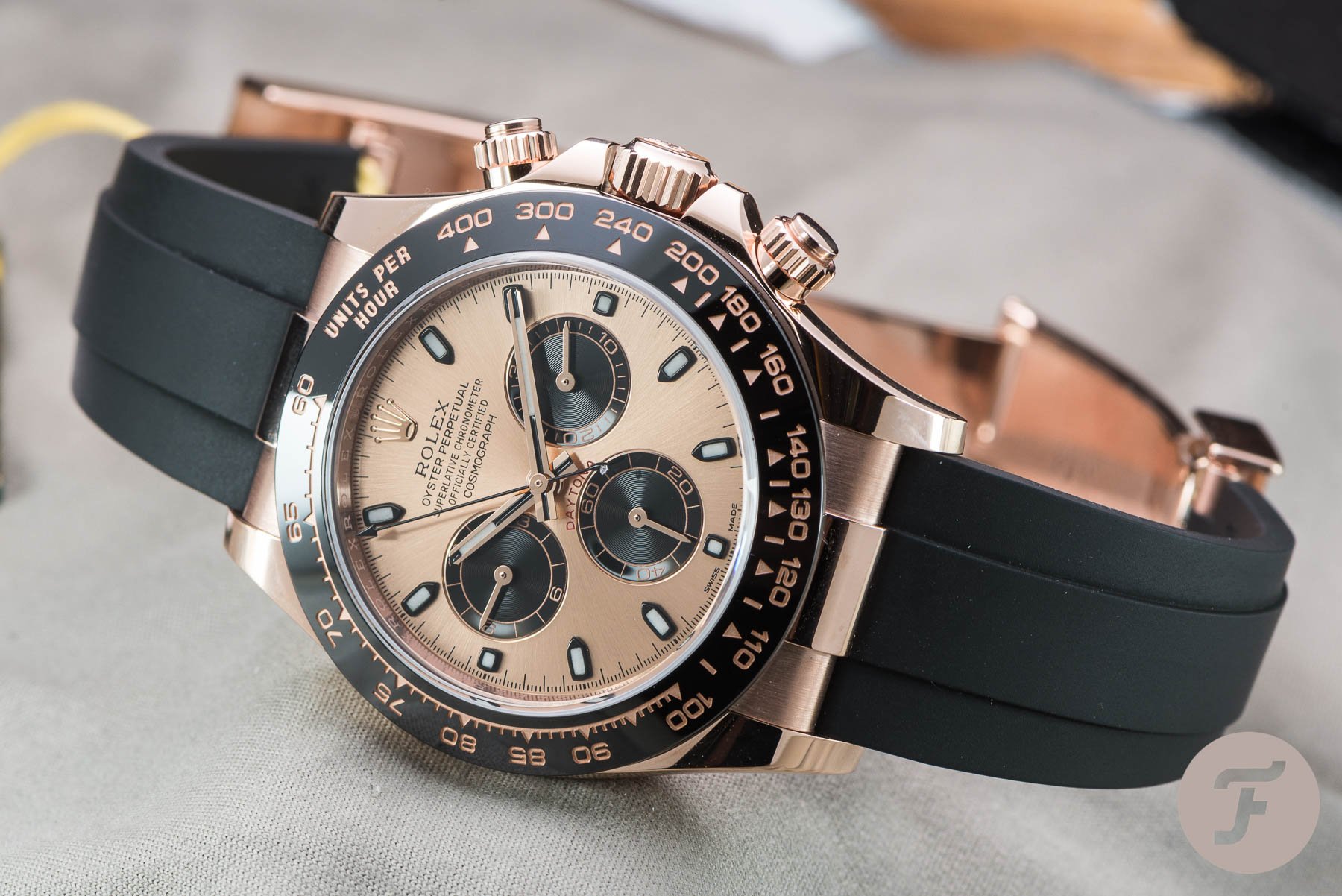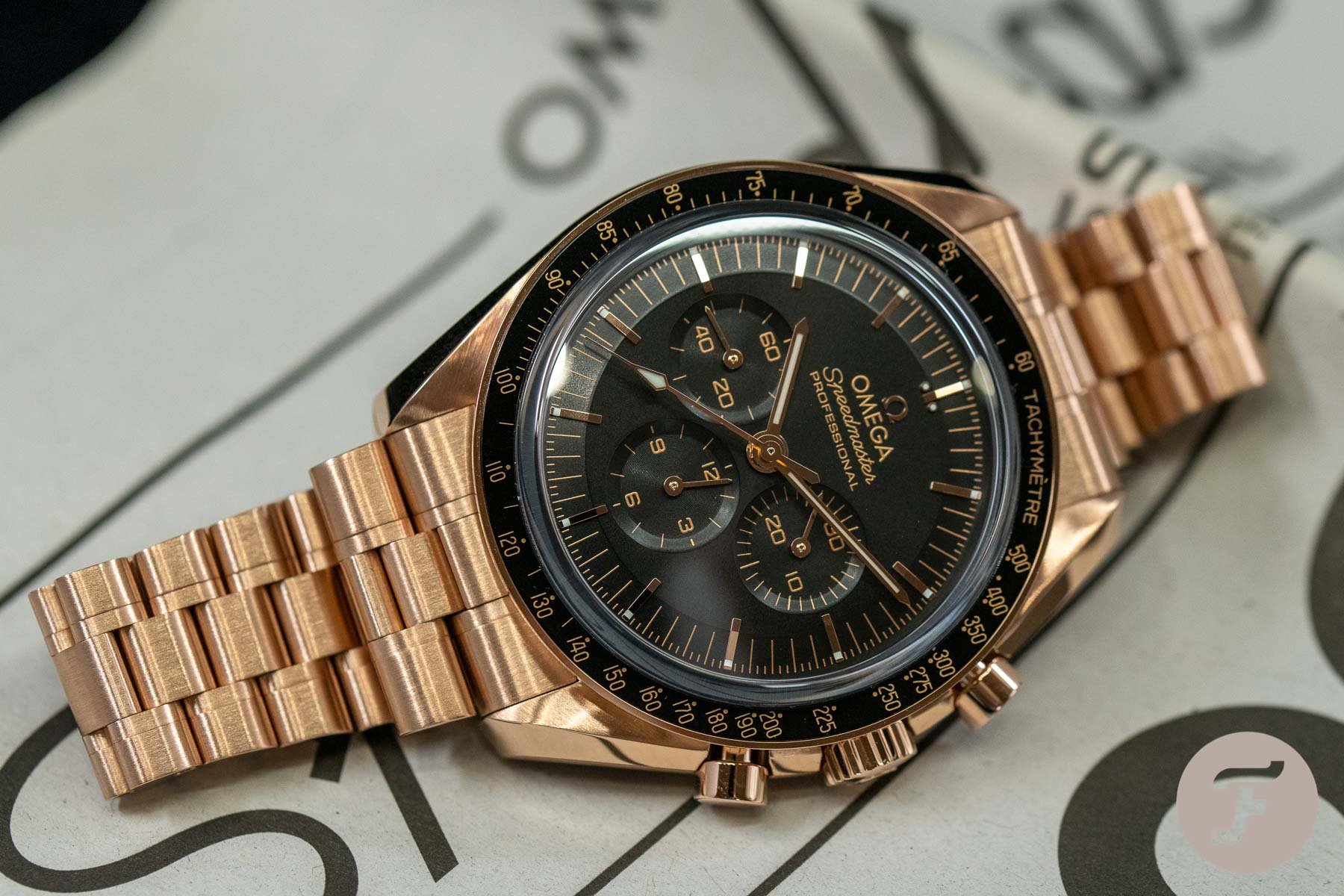Sunday Morning Showdown: Gold Chronographs — Rolex Daytona Everose Vs. Omega Speedmaster Sedna
In our Sunday Morning Showdown, two of our writers go head-to-head in an epic showdown for the ages. Strong opinions and hysterical hyperbole are welcome (so feel free to join in with the fun in the comments section below). And don’t forget to let us know which watches you’d like to see torn to shreds/effusively exalted next week. We’ll try and feature as many of our readers’ choices as we can. In this week’s showdown, the Everose gold Rolex Daytona faces off against the new Sedna gold Omega Speedmaster.
It’s not a first that the high-ranking champions of iconic chronographs square up against each other. Nor even is it the first scuffle between the two in our Sunday Morning Showdown series. The Speedy Calibre 321 “Ed White” already took on the black dial steel Daytona last year. And guess what, it won. So why the rematch? Well, this time, we’re giving attention to the proprietary gold alloys that make up the more illustrious iterations. While the new full Sedna gold Speedmaster is hot off the press, the Sedna compound itself has been around for some time. Likewise, Everose gold is Rolex’s answer to a problem that persists with aging gold watches.
Opening the gateway into Rolex
But before we get to that, there’s the matter of last week to unravel. In the previous Showdown, the clash of crowns was set to determine which steel model is the best gateway into Rolex. The term “gateway” was certainly questioned as prices for the Oyster Perpetual and Datejust are not exactly at the entry-level point. It’s important to note we assign the gateway description as a watch that pulls you into the wider world of mechanical timepieces. At the higher end of horology, we would also prescribe the Calatrava as the “gateway” Patek Philippe for would-be watch-nuts before discovering the Nautilus.
Just like the Calatrava to Patek, the Datejust is the bread and butter of Rolex. And that was proven with the 52% voting share over the Oyster Perpetual at 48%. Now, let’s turn our attention to today’s topic. It was partly inspired by a comment from our very own Auric Goldfinger, Robert-Jan Broer, on last week’s Showdown:
“…great write-up nevertheless, but can’t wait to see some gold here.”
Well, our writers certainly have it covered today, RJ. We’re pitting two proprietary gold sporty chronographs in an expensive game of chicken. Ben’s choice is the Rolex Daytona Everose reference 116515LN, whereas Jorg is repping the brand spanking new Omega Speedmaster Professional Sedna Gold reference 310.60.42.50.01.001.
Ben — Rolex Cosmograph Daytona Everose
Fresh from two wins on the bounce, I have a spring in my step for this morning’s match-up. Not least as it gives me the chance to talk more about the material science that makes up the most significant quantity of what we see on a watch. There’s a reason watch journos like to say “see it in the metal,” as the prevalence of the outer material, gold, in this case, occupies the majority of the visual space. This is why it makes it even more critical that the material maintains an everlasting sheen. But it wasn’t always this way. Gold in its natural form has to be refined and finished to be fashioned into jewelry. Even then, pure 24k gold is less than ideal for wrist adornments.
Typically, the various colors of 18k gold contain one or more of these elements; copper, silver, palladium, nickel, and platinum.
Gold is a luscious and vibrant material that is warm to the touch. It’s also soft in its purest form and needs other materials to form a stronger alloy. This is why we tend to see 18k on the spec sheets of gold wristwatches. 18k gold is 75% gold, or 750 parts per thousand, with the further 25% made up of a concoction of other elements as specified by the manufacturer. It’s in this 25% where creativity reigns supreme. Although, there have been watches in 24k gold that were heavily treated. Typically, the metal elements used to strengthen and vary the color hues of 18k gold range from; copper, silver, palladium, nickel, and platinum. However, it has not always been a successful endeavor.
Rolex Stelline Ref. 6062 18k Gold
The above watch is an example of what happens to 18k gold cases, even from Rolex, over time. This Rolex Stelline, or little stars, reference 6062, was made between 1950 and 1953. In the 50s, Rolex was in its prime for innovation, and the Stelline was one of the rare Rolex watches to include a moon-phase complication. A very Jules Verne moon design, no less, with star indices. More than that, and quite evident from this example, is the dark, oil-stain patina on the 36mm 18k gold case resulting from oxidation.
Pink and red gold cases often have a higher quantity of copper to achieve a more mature gold shade. If you’ve ever seen old pipes, you may recognize a similar color that you see in this case. The chlorine in tap water is usually the culprit, and copper also burns blue. It’s this metal content that impacts the oxidation of gold watches. This particular Rolex last sold at Christie’s in 2018 for $1,572,500, so indeed the buyer could look past the extensive patination — but Rolex could not. This is a rare watch, so it was not the only factor in its hammer price. And it’s not as if all gold Rolex watches would succumb to this dark color. But, in the background, Rolex was beavering away to ensure that its gold watches endure with an everlasting luster.
The Everose Daytona
In the Plans-les-Ouates foundry in Switzerland, Rolex perfected the compound and unveiled Everose gold to the world in 2005. And the first watch with Everose? The Cosmograph Daytona, of course.
Jorg: Is it really that obvious a choice? Especially when you have the Day-Date in your collection. The Day-Date embodies everything that makes a gold watch great.
Ben: The Day-Date got the Everose treatment eventually, but this is a big announcement and it needed a showpiece. The solution to protecting the case from toxins and shifting color tones was to include platinum in the mix. Platinum is a noble metal and is sometimes found in small doses in white gold watches but incredibly rare in rose gold. Though, it still took time for the compound to hit the sweet spot. Early Everose Rolex watches were just too pink in color, at least to my eyes. Rose gold should have a much warmer tone than Rolex was achieving at first.
Over time, and with continual improvements, Everose gold hit its stride. When the watch world was going mad in 2017 over Rolex attaching the Oysterflex bracelet to the trio of gold Daytonas, I was quietly admiring the new Everose. By god, Rolex did it. It brought into the world an Everose gold case that has a fantastic hue and keeps its radiance. It’s possible that earlier Rolex watches already had this particular Everose, but only by comparing to early Everose Daytonas was I able to ascertain this was a significant step-up. Both Omega and Rolex keep tight-lipped on each compound’s exact ratios, but Rolex fine-tuned the blend and process with a hint of special sauce.
The steel dilemma
I brought up how watch fans were hesitant to the 2017 white, yellow, and Everose gold Daytonas. The reason mostly lies with the Oysterflex bracelet or elastomer strap to us mere mortals. This option was only available with matching gold clasps, so not compatible with the stainless steel Daytona.
Jorg: Unfortunately a trade we see more often from the Crown: not giving the people what they want, even the ones that love the brand.
Not only that, but the proper application of panda dials in the modern Daytona era only came with a premium price of gold rather than steel. I reacted the same, as my budget can only stretch to utilitarian materials, but that does not stop me from lusting over this Everose Daytona. The gold is vibrant, but it is utterly captivating in tandem with the panda dial and black Cerachrom bezel.
To me, it is even nicer than the Rolex Yacht-Master in Everose gold from 2015 that first gave us the Oysterflex bracelet. Especially as the strap connects to end-links on the Daytona rather than right up next to the case as on the Yacht-Master. With the black Oysterflex bracelet, the case and dial appear more prominent. The black-coated rose gold chronograph seconds hand, and indices maintain a strong contrast. I believe this is one of the most legible configurations, a common complaint of the Daytona. I curse my wallet that it just does not make fiscal sense to spend €28,200 on this Daytona, but a man can still dream.
Jorg, please take over and talk about the Omega Speedmaster Sedna while I’m busy salivating.
Jorg — Omega Speedmaster Professional Sedna Gold
After two consecutive losses, I have a good feeling about this week’s majestic match-up Ben. However, I feel like the winner already. Not only does the new Speedmaster Professional in Sedna gold feed into the deepest desires of owning a gold Speedmaster, but you are also putting it against a Daytona. And if there is one Rolex that evokes the most powerful of mehs imaginable from me, it’s the modern-day Daytona. I understand the match-up against Rolex’s iconic chronograph is the most logical, but if it were the Yacht-Master in Everose you mentioned, I would have been lusting after two watches here.
The gold bracelets are the reason to buy these two watches.
But in my deepest of hearts, there is only one way to go when it comes to gold, and that’s all out! As Mike explained in his piece about the new gold Speedmaster Professionals, you would have to have a strong aversion towards bracelets to go any other way. One of the most talked-about features of the new Moonwatch line-up is the new bracelet. And after wearing both the Canopus gold and the Sedna gold version, I can only say that not only is there no way of hating them, they are the reason to buy these two watches. That is if your bank account has the room to do so without losing your house.
The first Sedna gold Moonwatch
Before I continue my praise of the new Speedmaster, Sedna gold is Omega’s proprietary 18k rose gold alloy. It was first unveiled in 2013 when Omega introduced a limited edition Constellation in Sedna gold. The material is a blend of gold, copper, and palladium that ensures that the watches’ unique rose gold hue will be long-lasting. As Mike said in his article, we have seen Sedna gold used for Speedmasters before, such as the Co-Axial Automatic and the First Omega in Space. But this is the first time Omega uses it for a Speedmaster Professional Moonwatch.
Ben: Sorry, Jorg, keep going. I’m still drooling over the Daytona and looking at which organs are my least utilized.
Jorg: I’ll continue, while the Canopus gold Speedmaster might have been the talk of the town at the introduction. Mostly for its unique presence, composition, and higher list price. But the Sedna gold version is the one that has the regal presence commonly associated with gold watches. Don’t get me wrong; the Canopus gold version is a brilliantly understated white gold Speedmaster. After wearing it, the thought of remortgaging my house was more potent than ever. It is my favorite out of the newly introduced Speedmasters. But there is something attractive about black and gold, as seen in the past for Speedmaster Professionals.
Gold Speedmaster Professionals
Speaking of the past, I want to touch upon the current appreciation of gold Moonwatches. If we go back just a couple of months to our Speedmaster World Cup, it was disappointing to find out that none of the coveted gold limited edition Speedmasters made it past the group stages. The Moonshine gold Apollo 11 50th Anniversary, the brilliant Apollo XI 345.0802, and even the grandfather of all limited editions, the Apollo XI BA145.022-69 failed to take the top spot in their groups. Is there a lack of love for gold Speedmasters?
The ultimate tool watch and not an opulent luxury statement.
While it seems like that from analyzing the results, I’m sure there isn’t. The most obvious reason is that the Speedmaster is the ultimate tool watch and not necessarily an opulent luxury statement in many fans’ eyes. Its legacy is built on its remarkable accomplishments in space rather than static proof of personal achievements. And that’s probably a big part of why the competing watches in each group eliminated all that gold bliss in our tournament. But in no way does that mean the Speedmaster cannot be a luxury statement. Even better, the new Sedna gold Moonwatch is a luxury statement with a great story.
All the features of a statement piece
It’s not just the materials used and the story that makes this a great luxury statement. It’s the total sum of all its elements that makes this a winner. The 42mm case based on reference 105.012 looks amazing in Sedna gold and is perfectly contrasted by the black aluminium Dot Over Ninety tachymeter bezel. Adding to its beauty is the incredible brass step-dial with a black coating contrasted by matching Sedna hands, applied indices and logo, dial printing, and bezel script.
If your turn the watch around, you will have a great view of the chronometer-certified Omega Calibre 3861. The movement features a Co-Axial escapement, uses anti-magnetic alloys, and is beautifully decorated. Besides the decoration of the movement, the watch’s overall finishing and quality feel are truly exquisite. It’s on a level that surpasses Rolex, especially considering the brilliant new bracelet.
The tapered bracelet is simply brilliant.
Speaking of which, from wearing the new Speedmasters, I can tell you that this tapered bracelet’s comfort that slims down to 15mm at the clasp is simply brilliant. It adds finesse and comfort, making this new Sedna gold Speedmaster Professional suited for a great variety of wrist sizes. That stunning bracelet is the reason to respectfully decline the option of the Sedna gold version on a leather strap that comes in €10,000 cheaper at €24,500. I would gladly cough up the €34,600 needed for the full Sedna gold Omega Speedmaster Professional.
And until that day comes, I’ll be in line with the rest of the commoners raving how good the Sedna gold Speedmaster Professional is and how much more impressive it is as a statement piece than your Everose Rolex Daytona, Ben.
Final words
Ben: It’s not about making a statement; it’s about being a statement. Both these watches shout it loud and proud that gold is not only the definition of luxury, but there is more in the mix than pure flash. In the end, Everose and Sedna are evenly matched, and I am glad to see the return of the full gold Moonwatch. But, as Jorg alluded to, there’s a sense of not being entirely comfortable with the shepherd Speedy in Emperor’s gold robes. The Rolex is no stranger to the regal life and struts its stuff in gold with aplomb.
Jorg: A gold Rolex might be a more common sight. But after more than five decades of gold Speedmaster Professionals, seeing a gold Moonwatch should not be a reason for any discomfort. And with the new Sedna gold Speedmaster Professional as a regular in the Moonwatch collection, Omega has created the perfect luxury statement for people who have and have not been captivated by the Speedmaster’s legacy. It’s a legacy that is simply a lot bigger than the metal it comes in, and why I would pick the Sedna Speedmaster every time.
But let’s ask our readers what their pick is. Will you take Everose Daytona or the Sedna Speedmaster? Now it’s your turn to decide.

